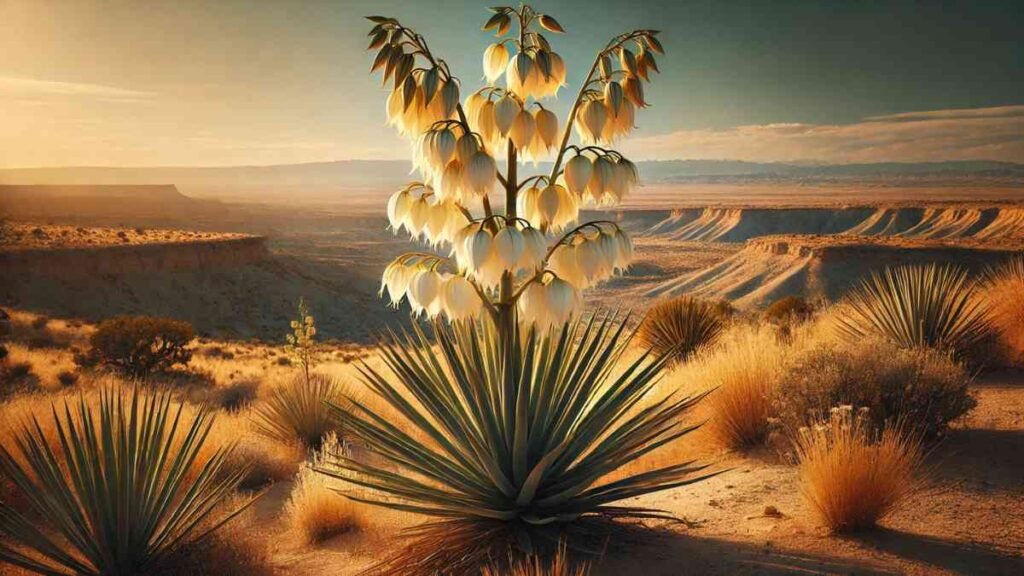Introduction
New Mexico state flower, the yucca, is a captivating symbol of the region’s unique beauty and resilience. Designated in 1927, the yucca flower is more than just an emblem of New Mexico; it embodies the essence of the state’s arid landscapes, cultural heritage, and ecological diversity. Known for its striking sword-like leaves and clusters of creamy white, bell-shaped flowers, the yucca is a plant of remarkable utility and charm. This article delves into the fascinating aspects of the yucca, its cultural significance, and its ecological role.
History of the New Mexico State Flower
New Mexico chose the state flower of New Mexico, the yucca, through a democratic process involving schoolchildren and the support of the New Mexico Federation of Women’s Clubs. The choice reflects the deep connection between the state’s inhabitants and the yucca plant, which thrives in its harsh desert climate.
Officially adopted on March 14, 1927, the legislation did not specify a particular species, but common varieties include the soaptree yucca (Yucca elata) and the soapweed yucca (Yucca glauca). These species are well-adapted to New Mexico’s arid conditions and are iconic features of its desert landscapes.
Characteristics of the Yucca
The yucca is a perennial shrub known for its:
- Sword-like leaves: These sharp, fibrous leaves grow in rosettes, forming the base of the plant.
- Tall stalks: During blooming season, the plant produces tall stalks adorned with clusters of creamy white flowers.
- Bell-shaped blossoms: The flowers emit a sweet fragrance and are visually stunning against the stark desert backdrop.
Yucca plants bloom in early summer, transforming the arid desert into a landscape of luminous beauty. Early settlers referred to these blossoms as “our Lord’s candles” due to their glowing appearance under moonlight.
Cultural Significance
The yucca has been a vital resource for Native Americans and early settlers. It served various practical and cultural purposes, such as:
- Soap and cleansing: The roots contain saponins, which create a natural lathering effect, making them a useful soap substitute.
- Fiber production: The fibrous leaves were used to make ropes, baskets, mats, and sandals.
- Food source: Different parts of the yucca, including its flowers, fruits, and seeds, are edible and have been incorporated into traditional diets.
- Medicinal use: Yucca extracts were used in traditional remedies for skin ailments and joint pain.
Ecological Role
The yucca plays a crucial role in its ecosystem. It has a unique symbiotic relationship with the yucca moth, its primary pollinator. Here’s how the partnership works:
- The moth collects pollen from one yucca flower.
- It deliberately transfers the pollen to another flower while laying eggs in the ovary.
- The larvae feed on some of the developing seeds, ensuring mutual survival and reproduction.
This intricate relationship highlights the interconnectedness of desert ecosystems and the adaptability of life in harsh environments.
Adaptability and Resilience
The yucca’s ability to thrive in New Mexico’s arid climate is a testament to its resilience. It has deep roots that seek water far below the surface and tough leaves that minimize moisture loss. These adaptations make the yucca a symbol of perseverance, much like the people of New Mexico who have adapted to the challenges of desert life.
Celebrating the Yucca
New Mexico honors its state flower through various means:
- Art and literature: The yucca often features in local artwork, poetry, and stories, symbolizing the spirit of the Southwest.
- Tourism: Visitors to New Mexico can see yuccas blooming in national parks and desert landscapes, adding to the state’s natural allure.
- Education: Schools highlight the yucca’s significance, teaching students about its ecological and cultural importance.
Conclusion
The New Mexico state flower, the yucca, is more than a plant; it is a beacon of the state’s heritage and natural beauty. Its striking appearance, practical uses, and ecological significance make it a fitting symbol for New Mexico. By understanding and appreciating the yucca, we celebrate the resilience and interconnectedness of life in the desert.
For More Visit, MirrorMagazine.co.uk


